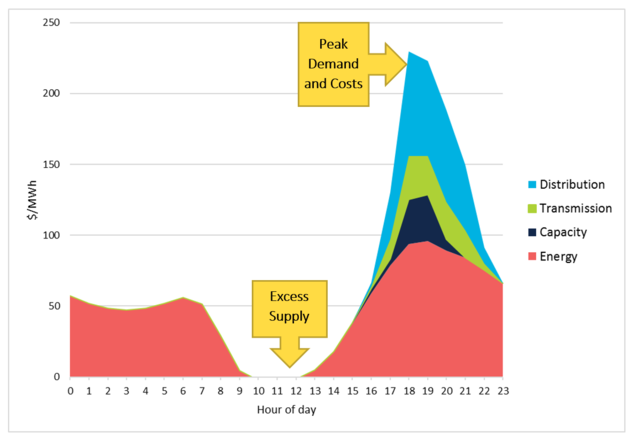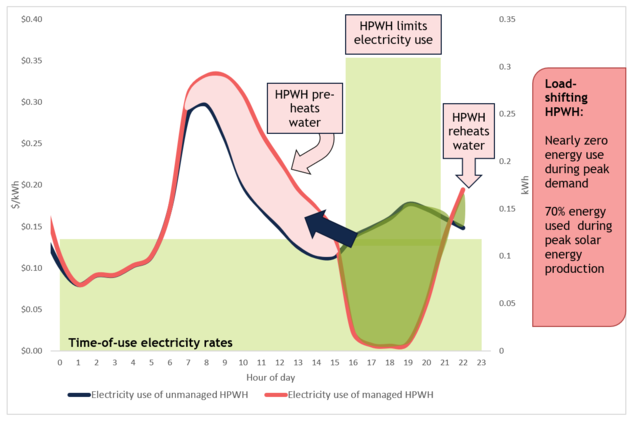Heat pump water heaters (HPWH) are a game-changing technology that can eliminate climate and air pollution from water heating in buildings. And if that isn’t enough, HPWHs have a less well-known added benefit: they can double as clean-energy batteries by essentially storing emissions-free solar energy to use during times when the sun isn’t shining.
That’s the conclusion of the California Public Utilities Commission, which found last summer that heat pump water heaters can provide effective, local energy storage to balance the grid. California has ambitious goals to deploy energy storage to harness plentiful but variable solar energy, and electric heat pump water heaters can help.
Currently, California’s residential and commercial buildings consume more gas than—and produce seven times as much air pollution as—power plants in the state. Eliminating gas use in buildings is critical to meeting clean air and climate goals. Switching from gas-fired furnaces and water heaters to efficient electric heat pump technology—already the lowest-cost path to zero-emissions buildings—is only more attractive when one considers HPWH energy storage benefits.
How Can a Heat Pump Water Heater Be a Battery?
Heat pump water heaters (HPWH) use electricity to heat water, functioning like a refrigerator running backward. They collect, concentrate, and move heat from the air around them into water in the tank, instead of moving heat out of the refrigerator. HPWHs are currently the most efficient electric water heating technology, three to five times more efficient than gas water heaters.
HPWHs also can provide another critical benefit—they can act as thermal “batteries” to store renewable energy (such as when solar energy is abundant in the middle of the day), and avoid using electricity in the evening, when it is more likely to be generated by the dirtiest power plants. With good tank insulation, it is possible for the water in the storage tank to stay hot enough for at least 12 hours, or even longer with well-insulated pipes and fittings.
Matching Demand with Supply
Traditionally, electricity is produced as needed to meet customer demand. To ensure there is always electricity available when a customer flips a light switch, utilities must keep power plants ready on the grid to meet the maximum amount of power that might be needed. This maximum is called “peak demand,” which in California typically occurs in the early evening when people return home, turn on the air conditioner, start to cook dinner, and watch television.
Although California’s peak electricity demand occurs in the evening, the state’s available clean energy supply peaks during midday when the sun is shining the brightest. This misalignment means that we cannot always consume the renewable energy we produce, and must still rely on expensive and polluting fossil fuel power plants to meet evening peak demand because don’t have enough storage capacity or demand flexibility to shift zero-emission solar electricity for later use.
On most days in California, the cost of producing one more unit of electricity (known as the “marginal” cost) spikes dramatically during peak demand hours, which occur between 4 p.m. and 9 p.m., depending on location. Transmission and distribution lines need to be built out, and reserve capacity needs to be kept available to meet peak demand, which all add up to the cost of meeting the highest amount of electricity use. Conversely, marginal production cost plunges to zero or even negative in the middle of the day when supply exceeds demand, leading to curtailment of some solar generation.
 PG&E 2024 Marginal Costs (Average Day Over the Entire Year), NRDC 2018
PG&E 2024 Marginal Costs (Average Day Over the Entire Year), NRDC 2018 This mismatch will hinder California’s pursuit of a fully decarbonized grid if unresolved. That’s where flexible electric loads like HPWH can help.
Load Shifting for Savings
Independent grid managers orchestrate electricity production using price signals and dispatch commands, which tell power plants when to ramp generation up or down. These same signals can be sent to electric appliances to help automatically manage demand. Demand-flexible HPWHs can also respond to time-of-use utility rates or grid signals to optimize when they operate, minimizing bills automatically without customer action.
How does this work? Heat pump water heaters act as thermal batteries, storing water heated with abundant clean electricity produced during the day for use in the evening. Much in the way that a phone battery “charges” when it’s convenient and can then be used on-the-go all day, HPWHs can heat water many hours in advance and still provide piping-hot showers during the evening.
This can effectively help “shift” electricity demand away from peak hours, to hours when low-cost and emissions-free renewable electricity is abundant. Internet-connected, or “smart,” HPWHs provide cost savings with no compromise on hot water availability. A properly-sized HPWH can store enough hot water to meet household needs without recharging during peak times. And when many of these water heaters are used together across the state, they can provide system-wide cost savings and emissions reductions that benefit all.
A 2018 modeling study found that HPWHs can shift their entire evening electricity load into the middle of the day’s solar peak, with 70 percent of the water heater electricity use taking place while solar power is abundant and low-cost, and almost no power used during the evening peak when electricity is dirtiest and most expensive.
 Electricity use of heat pump water heaters with (pink line) and without (black line) load shifting
Electricity use of heat pump water heaters with (pink line) and without (black line) load shifting Policy Needs
Heat pump water heaters that shift energy loads can be an essential part of our clean energy transition, but we need policies that enable their market adoption and ensure they are used to maximize grid benefits, including:
Encouraging builders to install heat pump water heaters when constructing new homes, by providing compliance credits under California’s building code and direct incentives to lower the installation cost. NRDC led a collaborative of manufacturers, utilities, and service providers to develop a specification for load-shifting HPWHs, and we expect the California Energy Commission to implement it in the state’s building code.
Facilitate market transformation of HPWHs by offering rebates through California’s Self Generation Incentive Program (SGIP), following the lead of photovoltaic panels where incentives were instrumental in bringing down the cost of solar energy to the point where the market is now thriving without incentives.
Reflecting marginal electricity costs in time-of-use rate design with a significant ratio of peak to off-peak electricity costs, to allow flexible loads like HPWHs to operate on low rates during off-peak hours, thereby encouraging load shifting sufficiently to spur market demand.
Heat pump water heaters are capable of storing clean energy and reducing strain on the grid during peak electricity demand. But we need appropriate policies to ensure they can fulfill those functions.